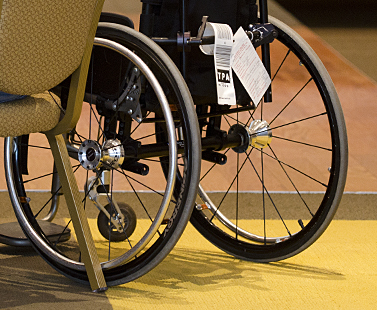Drug first to demonstrate neurological improvement in patients with Friedreich’s ataxia
Preliminary trial findings shared with FARA-USF research symposium participants
For the first time, an investigative drug has significantly improved the neurological function of patients with Friedreich’s ataxia.
The promising findings of a preliminary clinical trial testing the drug candidate known as EPI-A0001 was greeted with applause and cheers August 25 at the third annual scientific symposium hosted by the Friedrich’s Ataxia Research Alliance (FARA) and the University of South Florida Ataxia Research Center directed by Theresa Zesiewicz, MD, USF Health professor of neurology.

Among the symposium attendees were Christopher Nercersian and Natchez Hanson. Hanson, a college senior, participated in the patient panel discussion.
FARA Executive Director Jennifer Farmer presented results of the double blind, placebo-controlled 28-day study conducted by Edison Pharmaceuticals, Inc., because the travel of speaker Guy Miller, MD, PhD, Edison’s CEO, was delayed by Hurricane Irene. The study found measures of balance and coordination were significantly better in the group of patients given high doses of EPI-A0001 as well as the group receiving lose doses of the drug in comparison to the placebo group. There were no differences in rates of adverse side effects between the placebo group and each of the drug-treated groups.
“This is the first clinical trial where patients were given a drug and they’ve shown neurological improvement,” Farmer said. “It’s incredibly hopeful… but there’s still a lot of work ahead. We need to show the drug really makes a difference over six months or a year.”
FARA is working with the patient community, Edison and clinical investigators on the next step toward a treatment for Friedreich’s ataxia — long-term clinical trials of EPI-A0001 to verify the data. The rare degenerative neuromuscular disease, marked by progressive loss of balance, coordination and muscle strength, can also impair speech, vision, hearing and lead to diabetes and potentially life-threatening cardiac disease. There is no cure yet.

Scientists, clinicians, advocates, patients and their families gathered for the 3rd annual symposium, the kickoff leading to the FARA Energy Ball, a fund-raiser to advance research for Friedreich’s and related ataxias.
The “Cultivating a Cure” symposium at USF brought together scientists, clinicians, advocates and patients and their families who all share a passion for rapidly translating promising research into effective treatments for Friedreich’s ataxia and related disorders. The USF Ataxia Research Center is one of 11 sites nationwide in which clinicians and basic scientists work together, offering a full translational and multidisciplinary approach to understanding ataxia while searching for a cure.
“We all want to make Friedreich’s ataxia a historical disease – one that we only talk about in the past tense,” said Stephen Klasko, MD, MBA, CEO of USF Health and dean of the College of Medicine, who serves on the FARA Board of Directors.

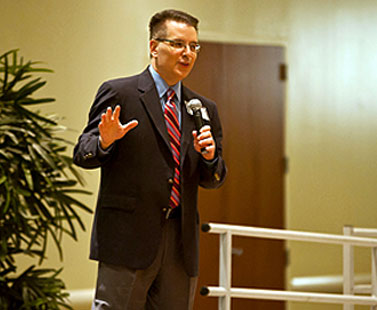
Dr. Theresa Zesiewicz directs the USF Ataxia Research Center, which hosts the symposium with the Friedreich’s Ataxia Research Alliance. Dr. Clifton Gooch, chair of neurology, recognized the rapid progress toward ataxia treatments in his closing comments.
Ron Bartek, president and co-founder of FARA, spoke about progress nationwide in the research and management of Friedreich’s ataxia. Basic science discoveries, funded in large part by FARA over the last several years, have led to six drug candidates, including EPI-A0001, currently in various stages of clinical trials. A seventh drug is expected enter a clinical trial by the end of this year.
“These drugs are not shots in the dark,” Bartek said. “I’m confident that out of these seven trials we will get our first FDA-approved treatment for Friedreich’s ataxia.”
Mark Napierala, PhD, assistant research professor at the University of Texas, MD Anderson Cancer Center, spoke about his research to identify new compounds that may help increase frataxin levels in people with Friedreich’s ataxia. A depletion of the protein frataxin has been associated with the impaired ability of mitochondria in nerve cells to make energy.

Clockwise from upper left: USF Health’s Dr. Stephen Klasko, Dr. Mark Napierala
of MD Anderson Cancer Center, and FARA’s Jennifer Farmer and Ron Bartek.
To assist with the drug discovery process, Dr. Napierala and colleagues developed a high-throughput method to analyze several hundred thousands of molecules in the search for activators of frataxin gene expression. The NIH recently awarded funding for Napierala’s high-throughput assay to go through the screening program at The Scripps Research Institute in Jupiter, FL.
The researchers plan to test candidate compounds identified from the screening process in Friedreich’s ataxia neuronal cell lines derived from pluripotent stem cells – adult cells genetically reprogrammed to a stem cell-like state. By the end of the screening campaign, Dr. Napierala said, they hope to pinpoint a few most promising compounds that can be further tested for development into functional drugs.
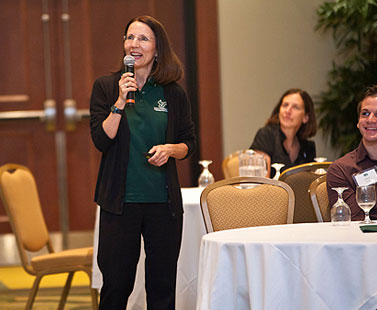
Jeannie Stephenson of the USF School of Physical Therapy & Rehabilitation
Sciences speaking about the FARA-funded longitudinal FA Biomarker Study.
Jeannie Stephenson, PT,MS, NCS, and Seok Hun Kim, PT, PhD, of the USF School of Physical Therapy & Rehabilitation Sciences (SPTRS), reported preliminary results of the FARA-funded longitudinal FA Biomarker Study. The findings demonstrated significant differences in gait and balance in several patients with Friedreich’s ataxia compared to matched healthy controls. The results also help establish the quantitative baseline data needed for this longitudinal study to be conducted by researchers at the USF Ataxia Research Center and SPTRS over the next two years.
If validated, Dr. Zesiewicz said, such biomarkers would help evaluate the effectiveness of investigational treatments, rather than relying on clinical rating scales alone, which tend to be more subjective and less sensitive.
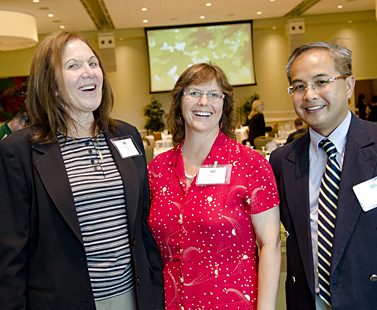
L to R: USF Health researchers Dr. Lynn Wecker (a symposium speaker),
Dr. Paula Bickford and Dr. Cesar Borlongan.
Lynn Wecker, PhD, distinguished research professor at USF Health, updated the audience on her studies investigating the effect of nicotinic drugs, like the smoking cessation drug varenicline, on an animal model for spinocerebellar ataxia type 3. All the nicotinic agonists (molecules that stimulate neuronal nicotinic receptors) that Dr. Wecker and colleagues have tested to date improve the motor performance of rats with cerebellar degeneration that exhibit ataxia symptoms.
In addition, the USF researchers have shown that nicotinic compounds protect neuronal cells from the toxic effects of oxidative stress and rescue “sick” neuronal cells from death. These preliminary results led to a five-year, $1.5 million grant to Dr. Wecker from the National Institutes of Neurological Disorders and Stroke to further investigate whether nicotinic compounds increase certain growth factors needed for cell survival.

During the panel discussion, patients spoke candidly about
living with Friedreich’s ataxia.
Crystallizing the importance of all the research shared, a patient panel discussion moderated by Dr. Klasko and Dr. Zesiewicz followed the scientists’ presentations. Kyle Bryant, Natchez Hanson, Nathan Bell and Mary Vida spoke candidly about the challenges of living with Friedreich’s ataxia and how health care practitioners could help improve the quality of life for patients.
When asked about biggest accomplishments, Natchez Hanson, diagnosed with Friedreich’s ataxia in 2006, said she seized the opportunity to study abroad in Florence, Italy, and looks forward to graduating with a bachelor’s degree in math education this May so she can teach high school math.
Though her future is uncertain, Hanson said, she continues to try her best and refuses to fail. “Everyone has some burden to bear — something stopping them that they need to overcome… “I can’t wait to inspire my students that are capable of doing anything they want.”
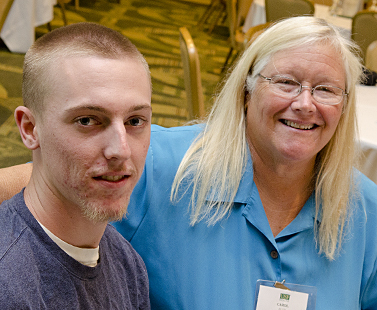
Brett Reed, 19, diagnosed with Friedreich’s ataxia at age 12, with mother Carol.
In his closing comments, Clifton Gooch, MD, professor and chair of neurology, thanked the philanthropists, researchers, clinicians, patient and families gathered for their determination in helping to quickly advance ataxia discoveries.
“What’s happened in Friedreich’s ataxia research over the last five to 10 years usually has taken 30 to 40 years in other neurological diseases,” Dr. Gooch said.
“Over the last decade we’ve gone from a fundamental cellular understanding of the disease to an entire array of potential therapies, some now in clinical trials and showing early promise in a disease that heretofore has been untreatable,” he said. “That is a phenomenal accomplishment.”
– Story by Anne DeLotto Baier, USF Health Communications. Photos by Eric Younghans, USF Health Communications, and Kent Ross Studios.



